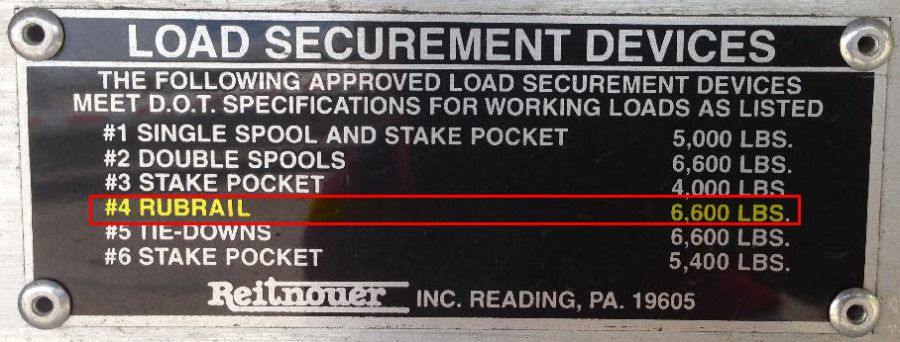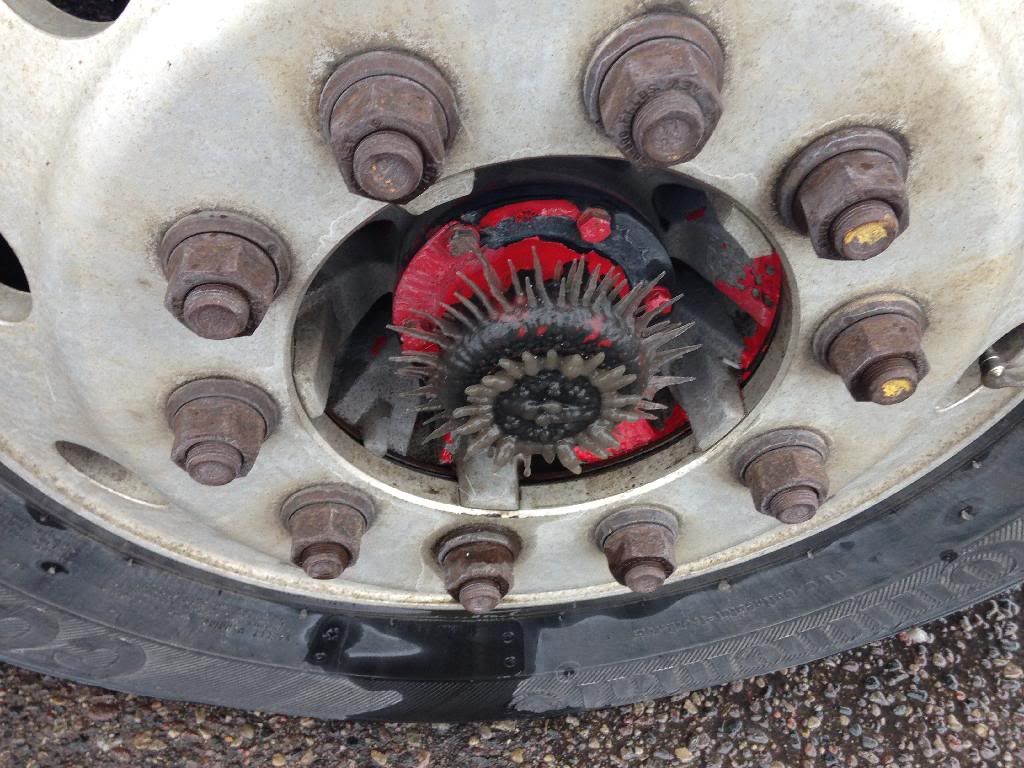Taking A Look At Securing A Flat-Bed Load
Topic 3287 | Page 5



In an earlier post within this thread, OldSchool mentioned that tie-down equipment should not extend to the outside of the rub-rail, which I was also taught oh-so-many years ago. The intent of the rub-rail is (or at least, WAS) to protect the tie-down equipment from getting damaged in the event of the trailer getting hit, bumped, scraped, or yes, even rubbed, by another vehicle or permanent structure during a turn or something.
This plate is indicating that it is acceptable to go around the rub-rail. Clearly, the manufacturer has tested and approved the strength of the rub-rail, but aren't they overlooking the safety issue having strap or chains on the outside of the rail?
I haven't driven trucks since the 1970's so it is possible that something has changed, but it's just not sitting well with me. Could someone possibly clarify this?
LittleJoe

In an earlier post within this thread, OldSchool mentioned that tie-down equipment should not extend to the outside of the rub-rail, which I was also taught oh-so-many years ago. The intent of the rub-rail is (or at least, WAS) to protect the tie-down equipment from getting damaged in the event of the trailer getting hit, bumped, scraped, or yes, even rubbed, by another vehicle or permanent structure during a turn or something.
This plate is indicating that it is acceptable to go around the rub-rail. Clearly, the manufacturer has tested and approved the strength of the rub-rail, but aren't they overlooking the safety issue having strap or chains on the outside of the rail?
I haven't driven trucks since the 1970's so it is possible that something has changed, but it's just not sitting well with me. Could someone possibly clarify this?
LittleJoe
I understand what you are saying about the possibility of chains/straps being damaged by rubbing against a permanent structure or another vehical but don't you think if those two things are happening the last thing you would be worried about at that exact moment would be your chains and straps? I don't know. Maybe you have to wonder why you are rubbing again a object that is stationary and was there first or maybe worry about why you and another vehicle are touch in the first place? At that point you could check the straps and chains for damage after those events are over with.
HOS:
Hours Of Service
HOS refers to the logbook hours of service regulations.Yeah, he's probably thinking more along the lines of what if during the course of an accident a truck rubbed against the side of you, broke a couple of straps or chains, and now the load comes flying off there in the wreck. That would be less than ideal.

GuyJax, You're right, at that precise moment, I really wouldn't be thinking about the straps or chains. I wasn't really thinking about ME being the cause. Hopefully, I'd be a better driver than that and be fortunate enough to not have put myself into that situation.
But let's suppose for a moment, that you're taking your daily shower in the truck stop and some bonehead scrapes your trailer in a way that is just enough to score the strap. During your pre-trip, you tug on the straps and find that they are tight, but in the dark, you may not notice the slight cut/scrape in the strap. Consider also, that said bonehead, after realizing what he's done, pulls out and moves to another spot, so as to not draw attention to himself. You now have no way of knowing what MAY have happened.
I know, pretty specific set of circumstances, but I'm just playing the devils advocate here. Hopefully, your pre-trip will reveal the issue. But wouldn't this possibility make you think twice about having your securement exposed to the danger?
I'm really over-thinking this, aren't I? 
LittleJoe
TWIC:
Transportation Worker Identification Credential
Truck drivers who regularly pick up from or deliver to the shipping ports will often be required to carry a TWIC card.
Your TWIC is a tamper-resistant biometric card which acts as both your identification in secure areas, as well as an indicator of you having passed the necessary security clearance. TWIC cards are valid for five years. The issuance of TWIC cards is overseen by the Transportation Security Administration and the Department of Homeland Security.
OWI:
Operating While Intoxicated

I'm really over-thinking this, aren't I?
LittleJoe
Yes, that's "ThinksTooMuch's" job . . . to over think it . . . thinks too much, get it? Oh well . . .
Jopa


GuyJax, You're right, at that precise moment, I really wouldn't be thinking about the straps or chains. I wasn't really thinking about ME being the cause. Hopefully, I'd be a better driver than that and be fortunate enough to not have put myself into that situation.
But let's suppose for a moment, that you're taking your daily shower in the truck stop and some bonehead scrapes your trailer in a way that is just enough to score the strap. During your pre-trip, you tug on the straps and find that they are tight, but in the dark, you may not notice the slight cut/scrape in the strap. Consider also, that said bonehead, after realizing what he's done, pulls out and moves to another spot, so as to not draw attention to himself. You now have no way of knowing what MAY have happened.
I know, pretty specific set of circumstances, but I'm just playing the devils advocate here. Hopefully, your pre-trip will reveal the issue. But wouldn't this possibility make you think twice about having your securement exposed to the danger?
I'm really over-thinking this, aren't I?
LittleJoe
Yes over thinking it a little bit. You have to make it a habit,not just flatbedders but everyone, that anytime you leave your truck unattended for more then a few minutes you need to check out your truck and trailer when you come back. Cause hit and runs are not to uncommon unfortunately.
As for the night time scenario that is why you have a really good flash light. MAGLITE is a good brand. The only place your straps/chains could get damaged it at the rub rail and a flashlight will show you the damage.
At the rub-rail you are only looking at a 4 inch wide 2 inch tall area which is the part on the outside of the rail. If you can't see the damage in that little area with a flashlight I would say you might want to holler at a eye doctor cause you might need glasses.
TWIC:
Transportation Worker Identification Credential
Truck drivers who regularly pick up from or deliver to the shipping ports will often be required to carry a TWIC card.
Your TWIC is a tamper-resistant biometric card which acts as both your identification in secure areas, as well as an indicator of you having passed the necessary security clearance. TWIC cards are valid for five years. The issuance of TWIC cards is overseen by the Transportation Security Administration and the Department of Homeland Security.
OWI:
Operating While Intoxicated

Old School,
I got a question. Somehow, I missed this topic when it first started. The one thing that I have not seen mentioned is:
You use a direct connection with your chains. For those of you that do not know what that means, it means the chain connects to one side of the trailer and connects directly to the cargo being secured or the chain goes through a securement point and then connects to the same side of the trailer. When using direct connections, don't you have to half your WLL of your chain? That means each chain you used only could hold 2350 lbs. It was hard to see in the picture but I am pretty sure it was a direct connection.
Just for those trying to learn, an indirect connection is when the chain goes through a securement point on the cargo and connects to the other side of the trailer.
Did I miss understand this concept, Old School?
HOS:
Hours Of Service
HOS refers to the logbook hours of service regulations.Old School, thank you for the excellent photos! I now know what a rub rail, spacer, and stake pocket are. Not quite what I had pictured in my head. Even though it's not likely that I'll be a flatbed driver (!), I still like to learn about it. Knowledge is power!

Boy, I am late to this party! Old School, great job on flatbedding 101 and, as you said, getting any agreement between what is "right" or "legal" is a lot like politics. At Melton, with our trailers, we use either the spool or the pocket. The preference is the spool when possible, but that doesn't always work out when you get everything loaded and you have to start chaining.
It was interesting to see how you did your eye to the sky coils. Any of them that I have done have been with 3 straps arranged in a "star" pattern when skidded. Chaining the skid is always a good idea, too. We are strongly encouraged to build a bulkhead whenever there is room just as another bit of safety. Just another bump, if you like, for those suicide coils to get over on their way toward your cab.
Like you, I always over secure factoring in one for momma, one for each of the kids and another for the grandson. My thinking is if it is good enough to be around mine, then yours are safe, too. Plus, securement not used is wasted securement. Don't get me wrong, I don't use all of my securement just to use it, but no one will ever say I didn't have enough.
The rub rail issue is always one of interest and discussion. At Melton we are trained to route the strap through the rub rail and hook it back to the rub rail. I have guys tell me that DOT will hammer you for that in TX, NC and other states. The reasoning is that if someone rubs your rails  it will cut the straps with bad consequences. As our safety guy put it to a DOT officer, if that happens you have a lot other problems, too. Even the regs are wishy washy on it with no specific guidance.
it will cut the straps with bad consequences. As our safety guy put it to a DOT officer, if that happens you have a lot other problems, too. Even the regs are wishy washy on it with no specific guidance.
Another thing that should be stressed is the alternating pull on securement since there is a possibility that freight could "twist" if the pull is only to one side. That goes for both chains and straps.
The thing about flat bed is that you have to think about what the load is and then plan how you are going to secure it. Sometimes it takes me longer to plan it than to secure it. We haul a lot of layered loads and making sure you have two straps per layer can sometimes get interesting. Then there are the times you don't have enough straps or ratchets to do that. Bottom line, you have the regs you must know and follow (the science, if you will) but you have to use your imagination (the art) at times to work with the load and the equipment that you have.
Then there is the issue of tarping..........
Bulkhead:
A strong wall-like structure placed at the front of a flatbed trailer (or on the rear of the tractor) used to protect the driver against shifting cargo during a front-end collision. May also refer to any separator within a dry or liquid trailer (also called a baffle for liquid trailers) used to partition the load.
DOT:
Department Of Transportation
A department of the federal executive branch responsible for the national highways and for railroad and airline safety. It also manages Amtrak, the national railroad system, and the Coast Guard.
State and Federal DOT Officers are responsible for commercial vehicle enforcement. "The truck police" you could call them.
HOS:
Hours Of Service
HOS refers to the logbook hours of service regulations.New Reply:
New! Check out our help videos for a better understanding of our forum features

















Preview:
This topic has the following tags:
Driver Responsibilities Flatbed High Road Training Program Load Securement Photos Safe Driving Tips Understanding The Laws







 TT On Facebook
TT On Facebook
That's exactly what I'm talking about. There should be no misunderstanding about where you can tie down a load and how much force the tie-down areas can handle. The manufacturers know those specs. They have to submit them in order to get the trailer approved for highway usage. So you would think every trailer would have that type of information on it somewhere. Not only would a driver need that information, but so would a DOT officer while doing an inspection.
DOT:
Department Of Transportation
A department of the federal executive branch responsible for the national highways and for railroad and airline safety. It also manages Amtrak, the national railroad system, and the Coast Guard.
State and Federal DOT Officers are responsible for commercial vehicle enforcement. "The truck police" you could call them.
BMI:
Body mass index (BMI)
BMI is a formula that uses weight and height to estimate body fat. For most people, BMI provides a reasonable estimate of body fat. The BMI's biggest weakness is that it doesn't consider individual factors such as bone or muscle mass. BMI may:
It's quite common, especially for men, to fall into the "overweight" category if you happen to be stronger than average. If you're pretty strong but in good shape then pay no attention.
HOS:
Hours Of Service
HOS refers to the logbook hours of service regulations.